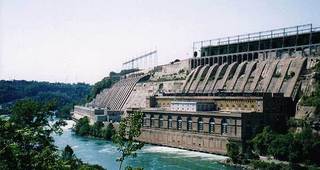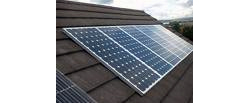Corporate Energy Consumption and Greenhouse Gas Emissions
Objective D2: Decrease Corporate Energy Consumption and Greenhouse Gas Emissions
The following actions are needed to complete this objective:
- Implement and update the Corporate Energy Management Plan and the Corporate Climate Action Plan.
- Implement retrofits and energy saving mechanisms with a payback time and greenhouse gas reductions.
- Consider energy consumption, life-cycle costing and greenhouse gas emissions when planning capital projects.
- Develop an energy awareness campaign for municipal employees.
- Assess current water usage across all municipal buildings.
These indicators show the progress the City is making to achieve this objective:
- Corporate energy consumption.
- Corporate greenhouse gas emissions (Goal A).
Energy Consumption Indicator
Why does Energy Consumption Matter?

Currently, electricity is generated in Ontario through hydroelectric (Niagara Falls hydroelectric generator shown on right), nuclear, coal, gas/oil, wind and biomass. Approximately 63 percent of the electricity generated in Ontario is from nuclear and gas/oil: non-renewable resources with large environmental impacts.
The Independent Electricity System Operation (IESO) predicts the hourly Ontario Demand (megawatts). To see Ontario's energy consumption for today visit the IESO website.
| Source of Electricity | Amount pre-2010 (Megawatts) | Amount as of June 2020 (Megawatts) |
Environmental Benefits/Concerns |
|---|---|---|---|
| Hydroelectric | 7,788 | 9,065 | Renewable, ecosystems altered |
| Nuclear | 11,419 | 13,009 | Non-renewable, nuclear waste, requires large quantities of water for cooling |
| Coal | 6,434 | 0 | Non-renewable, air pollution, large carbon footprint, waste ash generated, water required |
| Gas/Oil | 5,703 | 11,270 | Non-renewable, air pollution, carbon footprint, water required |
| Wind | 395 | 4,486 | Renewable, alters landscape |
| Biomass | 75 | 295 | Renewable, air pollution, carbon footprint varies depending on biomass used |
In 2017, Ontario’s electricity sector emitted 2.0 megatons carbon dioxide equivalent (MT CO2e) emissions, or 3% of total Canadian greenhouse gas (GHG) emissions attributable to power generation. Ontario’s GHG emissions from power generation peaked in 2000 at 43.4 MT CO2e and then saw emissions decline as it phased out coal-fired generation from 2005 to 2014. In 2017, The average Ontario household consumed around 722 kilowatt hours (kWh) per month compared to the average Michigan household that consumes 676 kWh per month (average US household consumes 903 kWh per month).
How are we doing?
Total energy consumption is one measure of how sustainable a community or business is. The City of Windsor consumes energy in our buildings and conducting wastewater treatment, as well as powering streetlights and traffic signals.

As seen in the chart above, the amount of electricity (in kWh) and natural gas (in metres cubed) consumed by City of Windsor buildings has increased since 2010. However, we are starting to see a decline in the amount of natural has being used, while simultaneously seeing an increase in the use of electricity.
Note: Significant increase in natural gas consumption between 2017 and 2019 correlates to the implementation of Combined Heat and Power (CHP) units at the WFCU Centre, Huron Lodge, and the Windsor International Aquatic and Training Centre Facilties, which resulted in decreased electricity consumption, while increasing natural gas consumption. When implemented the provincial government provided incentives to support installation.
Note, 2020: Windsor International Aquatic and Training Centre Presented by WFCU Credit Union and Chimczuk Museum closed due to the COVID-19 pandemic

As seen in the chart above, the amount of district energy (in megawatt-hours) consumed by City of Windsor buildings has increased since 2010. However, district energy usage has dropped off from peak level usage in 2018, but it starting to climb back up after a decline from 2020-2021.
Note, 2020: Windsor International Aquatic and Training Centre Presented by WFCU Credit Union and Chimczuk Museum closed due to the COVID-19 pandemic

As seen in the chart above, the amount of electricity (in kWh) consumed has remained constant, while natural gas (in cubic metres) consumed by City of Windsor sewage treatment plant operations has increased since 2010. However, natural gas usage has dropped off from peak 2019 levels.
Note: In 2019, the City acquired a biosolids pelletizing facility, resulting in higher corporate natural gas consumption for drying processes. Also in 2019 and 2020, high water levels in the great lakes resulted in higher amounts of wastewater due to high groundwater levels and system infiltration.

As seen in the chart above, the amount of electricity (in kWh) consumed by City of Windsor streetlights and traffic signals has decreased since 2010 and has remained constant since 2019.
What is the City of Windsor doing to reduce energy consumption?
- In an effort to reduce costs and energy use by the municipality, an energy audit has been completed for all facilities and a proposal for a Corporate Energy Management Plan has been developed.
- An energy retrofit program began in 2010 and included the following measures: upgrades to lighting, building efficiency, mechanical equipment and controls; and incorporation of renewable energy. By the end of 2013, the City has implemented $2,370,300 in energy and water-saving measures. These measures are anticipated to achieve annual hydro, gas and water savings of nearly $250,000.
- As part of the energy efficiency retrofit program, three solar outdoor pool water heating systems were incorporated into Lanspeary, Mic Mac and Remington Park pools. In addition, the City received an Ontario Power Authority Feed-In-Tariff (FIT) contract to install a 350 kW solar PV roof mounted system at the new Windsor International Aquatic and Training Centre presented by WFCU Credit Union. The system will produce approximately 518,000 kWh annually, generating $275,000 per year over the life of the 20 year contract.
- The City of Windsor has converted all traffic signals over to light emitting diode (LED) technology as the old bulbs failed or signals needed upgrading.
- After many successful pilot projects, the City has converted all street lights to LED fixtures citywide.
- The City of Windsor now operates two solar powered golf carts, which provide tours of the Windsor Sculpture Park to residents and visitors of Windsor. These carts replaced two electrical golf carts, therefore reducing energy consumption and greenhouse gas emissions.
- The City has created a new position entitled Supervisor of Energy Contracts which is 80% funded by the Ontario Power Authority. This employee assists with numerous new and ongoing energy initiatives, including implementation of energy saving opportunities within the corporation's building and facility portfolio.
- The City of Windsor has participated in Earth Hour, the Power Pledge Challenge, and Energy Conservation Week initiatives.
What can you do to reduce energy consumption?
Heating and cooling:
- Set your thermostat at 25°C during the summer. Ceiling fans and portable fans can help you feel cooler during the summer.
- Use programmable thermostats to reduce heating and cooling when you are asleep or away from home. Every degree's difference moves energy costs around 5 percent.
- During the summer, close curtains on sunny days and open them at night.
- Insulate hot water pipes in your basement.
- Use aluminum tape to seal the joints in your duct work in your basement.
- Install a low-flow showerhead - over the year, the amount of hot water you will save could fill a backyard swimming pool.
Lighting:
- Use compact fluorescent light bulbs in the busiest rooms in your home - these bulbs use 75 percent less electricity than incandescent light bulbs and last longer too. However, it is important to note that the compact fluorescent light bulbs contain small amounts of mercury. When these light bulbs reach the end of their life, they should be returned to retailers offering collection or to the Household Chemical Waste Depot.
- Use timers or motion sensors to control exterior lighting.
- Use light-emitting diode (LED) lights for holiday lighting - these use 75 percent less electricity than mini-lights and 98 percent less electricity than 5 watt incandescent bulbs.
Appliances and home electronics:
- Run your dishwasher and other electrical appliances on "off-peak" hours late at night. This "load-shifting" reduces electricity demands during the day.
- Unplug your second refrigerator or freezer if it is not being used: these can use $150 per year of electricity to keep running. Check out 's Great ENWIN's Refrigerator Round-Up Program for incentives.
- Replace old appliances (15 years old or older), such as refrigerators, clothes washers, freezers, and air conditioners: a new model of the same size can use 50 to 75 percent less electricity.
- Check your home electronics for "phantom load:" products such as a VCR, DVD player or TV can still draw power even when turned off. Plugging these into a power bar can be used to ensure that the power is turned off.
Invest in your home:
- Have an energy audit completed on your home, and complete as many suggestions as possible.
- Upgrade your home and receive grants and rebates from the governments of Canada and Ontario.
- Plant deciduous (leaf-bearing) trees on the south and west side of your home. Once fully grown, they will provide shade for your home in the summer but will allow the sun to warm your home in the winter. Carefully positioned trees can save up to 25 percent of the energy a typical household uses for cooling.
- Install a grid-tied solar photovoltaic system to offset greenhouse gas emissions from traditional electricity generation and produce a portion of your home's own clean, renewable energy.

For more information about incentive programs for homeowners, please visit the Ontario Ministry of Energy website.
Other sources for incentives and rebates include:
Other sources for conservation news include:
Corporate Greenhouse Gas Emissions Indicator
This indicator strongly relates to the Greenhouse Gas Emissions Indicator located in Goal A, Community Green House Gas Emissions. To learn more on the matter, head to the Greenhouse Gas Emissions Indicator.
